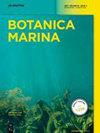Brazil-Malvinas Confluence in the South-West Atlantic Ocean: phytoplankton species, life forms and trophic mode
IF 1.4
4区 生物学
Q2 MARINE & FRESHWATER BIOLOGY
引用次数: 0
Abstract
Abstract The Brazil-Malvinas Confluence (BMC) is characterized by high environmental variability and represents a hotspot of phytoplankton biodiversity. This study has investigated the phytoplankton composition in the BMC and a Cold Core Eddy (CCE), with particular reference to the life forms and trophic modes of the species. Vertical hauls were performed between the maximum chlorophyll depth and the surface with a 20-μm mesh plankton net at six sampling points in the BMC (4 hauls) and CCE (2 hauls) during the austral spring (November 2019). Temperature and salinity were determined in situ. The Brazil Current and Malvinas Current in the BMC had different species compositions, and the CCE had greater similarity with the Malvinas Current. Autotrophic organisms (mainly diatoms) and marine planktonic oceanic and/or neritic life forms were predominant in the BMC and the CCE. Heterotrophic dinoflagellates were predominant in the Brazil Current and the CCE, while mixotrophic dinoflagellates in the Malvinas Current were associated with low temperatures and salinities. A high diversity of species was confirmed in the region, mainly associated with marine planktonic oceanic and/or neritic species, and there was a predominance of autotrophic organisms. The temperature conditions in the CCE promoted an increase in species richness in the region.西南大西洋巴西-马尔维纳斯汇流:浮游植物种类、生命形式和营养模式
巴西-马尔维纳斯汇流带(BMC)具有高环境变异性的特点,是浮游植物生物多样性的热点。本研究研究了BMC和冷核涡(CCE)中的浮游植物组成,特别是物种的生命形式和营养模式。在南方春季(2019年11月),利用20 μm网在BMC(4个)和CCE(2个)的6个采样点进行了最大叶绿素深度与地表之间的垂直追踪。温度和盐度就地测定。BMC中的巴西流和马尔维纳斯流具有不同的物种组成,CCE与马尔维纳斯流具有较大的相似性。自养生物(主要是硅藻)和海洋浮游生物和/或浅海生物形式在BMC和CCE中占主导地位。异养鞭毛藻在巴西海流和CCE中占主导地位,而混合营养型鞭毛藻在马尔维纳海流中与低温和低盐度有关。物种多样性较高,主要为海洋浮游和/或浅海物种,自养生物占优势。CCE的温度条件促进了该地区物种丰富度的增加。
本文章由计算机程序翻译,如有差异,请以英文原文为准。
求助全文
约1分钟内获得全文
求助全文
来源期刊

Botanica Marina
生物-海洋与淡水生物学
CiteScore
4.10
自引率
4.50%
发文量
43
期刊介绍:
Botanica Marina publishes high-quality contributions from all of the disciplines of marine botany at all levels of biological organisation from subcellular to ecosystem: chemistry and applications, genomics, physiology and ecology, phylogeny and biogeography. Research involving global or interdisciplinary interest is especially welcome. Applied science papers are appreciated, particularly when they illustrate the application of emerging conceptual issues or promote developing technologies. The journal invites state-of-the art reviews dealing with recent developments in marine botany.
 求助内容:
求助内容: 应助结果提醒方式:
应助结果提醒方式:


